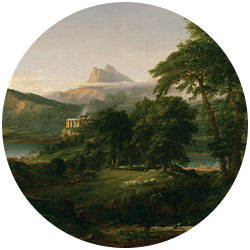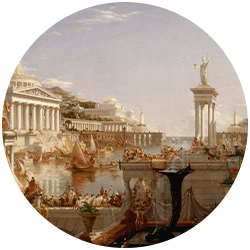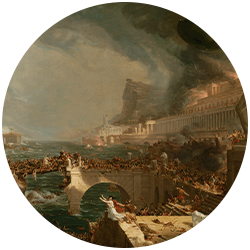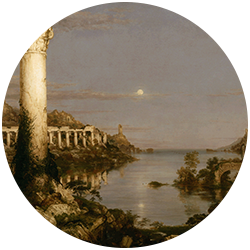The Course of Empire Series

The Savage State

The Arcadian or Pastoral State

The Consummation of Empire

Destruction

Desolation
Thomas Cole, The Course of Empire, 1834-1836, oil on canvas, 39 ¼ x 63 ¼ in., New–York Historical Society, Gift of the New-York Gallery of the Fine Arts, 1858.1-5
WithThe Course of Empire, Thomas Cole achieved what he described as a “higher style of landscape,” one suffused with historical associations, moralistic narrative, and what the artist felt were universal truths about mankind and his abiding relationship with the natural world. In a letter to his patron Luman Reed, Cole wrote enthusiastically of an idea for his first large-scale allegorical series:
A series of pictures might be painted that should illustrate the History of a natural scene, as well as be an Epitome of Man—showing the natural changes of Landscape & those effected by man in his progress from Barbarism to Civilization, to Luxury, the Vicious state or state of destruction and to the state of Ruin & Desolation.
The philosophy of my subject is drawn from the history of the past, wherein we see how nations have risen from the Savage state to that of Power & Glory & then fallen & become extinct… 1
Reed accepted the artist’s proposal, and Cole worked on The Course of Empire for the next three years. The five paintings were specifically designed for a prominent spot in Reed’s third floor picture gallery in his New York City mansion at No. 13 Greenwich Street. See Cole’s Installation Diagram for the Course of Empire. They chart the course of human civilization, while at the same time progressing through different times of day and various weather conditions, reflecting man’s changing relationship to his environment.
A trip to Europe (1829-32) deeply influenced Cole’s work. There he first saw the ruins of ancient civilizations, remnants of a past time that could not be found in America. See After Giovanni Battista Piranesi, The Colosseum. The Course of Empire also reflects the growing interest in ancient history among the elite. The title of the series derives from a well-known eighteenth-century poem by the British philosopher Bishop George Berkeley (1685-1753), entitled “Verses on the Prospect of Planning Arts and Learning in America” (1726). The poem alludes to five states of civilization and the implicit prophecy that America would prove to be the next great empire. Cole also read Lord Byron’s 1818 work, Childe Harold, (see J.M.W. Turner, Childe Harold’s Pilgrimage) and cited these lines in regard to his series:
There is the moral of all human tales;
‘Tis but the same rehearsal of the past.
First Freedom and then Glory—when that fails,
Wealth, vice, corruption—barbarism at last.
And History, with all her volumes vast,
Hath but one page. 2
Cole’s contemporary, novelist James Fenimore Cooper, marked the success of the allegorical series when he wrote in 1849, “Not only do I consider the Course of Empire the work of the highest genius this country has ever produced, but I esteem it one of the noblest works of art that has ever been wrought.” 3 See John Wesley Jarvis, Portrait of James Fenimore Cooper.
COLE’S WORDS:
I have had some difficulty in finding a comprehensive & appropriate title for the series of pictures which I am now painting for Mr. Reed. I have had several but have discarded all of them; but now I think I have a good one. Although it may perhaps be considered lofty & ostentatious[,] it is The Course of Empire.” 4
I have been dwelling on many subjects, and looking forward to the time when I can embody them on the canvas. They are subjects of a moral and religious nature. On such I think it the duty of the artist to employ his abilities: for his mission, if I may so term it, is a great and serious one. His work ought not to be a dead imitation of things without the power to impress a sentiment, or enforce a truth. 5
